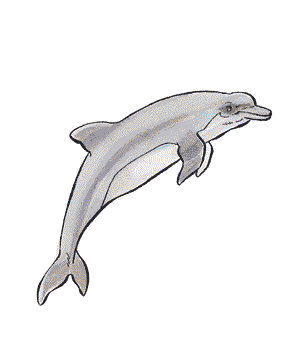

2140

| Climate/Terrain: | Any saltwater |
|---|---|
| Frequency: | Uncommon |
| Organization: | School |
| Activity Cycle: | Any |
| Diet: | Carnivore |
| Intelligence: | Very (11-12) |
| Treasure: | Nil |
| Alignment: | Lawful good |
| No. Appearing: | 2-20 |
| Armor Class: | 5 |
| Movement: | 30 |
| Hit Dice: | 2+2 |
| THAC0: | 19 |
| No. of Attacks: | 1 |
| Damage/Attack: | 2-8 |
| Special Attacks: | Nil |
| Special Defenses: | Save as 4th-lvl fighter |
| Magic Resistance: | Nil |
| Size: | M (5-6� long) |
| Morale: | Steady (11) |
| XP Value: | 120 |
Dolphins are intelligent seagoing mammals.
While all dolphins share a variety of common traits, the species comes in a variety of shapes and sizes. Their long, compact bodies are superbly adapted to the aquatic environment, and dolphins are among the most powerful swimmers in the oceans. All breeds of dolphins have a large fin on their backs, two flippers, a powerful tail, jaws filled with many sharp teeth, a blow hole, and are 5 to 6 feet long. Most common and well-known are the gray, or bottle-nosed dolphins, so named for their gray skin and bottle-shaped snouts. Other varieties have two-toned blue and gray coloring. The species communicates through an intricate speech consisting of high-pitched sounds, some out of the range of human hearing.
Combat: Inherently peaceful, dolphins will generally attack only if threatened. Unless outnumbered 2 to 1, dolphins always attack sharks. Whether attacking a foe or defending their school, dolphins fight as an organized unit, responding to commands from their leader. They fight with special vehemence to protect their young, and a select number of dolphins may sometimes engage in a holding action, sacrificing themselves so that the remainder of the school can swim to safety.
Habitat/Society: Dolphins are completely carnivorous, living on a diet of fish. Though they can remain submerged for several minutes at a time, they must surface regularly to breathe. Unlike most mammals, breathing is a conscious, rather than unconscious action on the part of dolphins; in other words, they literally must remember to breathe. Newborn dolphins are assisted to the surface to breathe by their mothers and a female dolphin midwife. Dolphins are by nature playful, good-tempered, and lawful good, despising evil creatures. Most roam the oceans in schools, numbering as large as 20 dolphins, swimming where their fancy suits them. They never fight among themselves or with other breeds of dolphins. Dolphins are famous for the great pleasure they take in life; when swimming they often perform dazzling aquatic stunts, leaping in and out of the water in a spectacular fashion. They will also play with objects that they find and enjoy games. Dolphins sometimes follow ships, entertaining the crews and passengers with their antics.
About 10% of all dolphins live in organized communities. These groups have 1d4+1 swordfish (AC 6, move 24, 1+1 Hit Dice, 2d6 points of damage/attack) or 1-3 narwhales (AC 6, move 21, 4+4 Hit Dice, 2d12 points of damage/attack) as guards, depending on the climatic region. If a community is found, there is a 75% possibility that there are 1d4 additional communities of dolphins within a five-mile radius. These organized communities of dolphins do not tolerate the presence of evil sea creatures in their domain, and if necessary enlist the aid of nomadic schools of dolphins to drive out evil creatures. Any region inhabited by dolphin communities is also shark and killer whale free.
Dolphins are highly intelligent and take a benign, distant interest in human doings. They will always help humans in distress, guiding them to the shore and keeping the sharks at bay. Certain solitary dolphins, known as rogues, have been known to form closer attachments to humans, accompanying them in a friendly fashion on swimming and fishing expeditions. These rogues often play dolphin games with their human companions. Dolphins are far more valuable to men in other respects. Friendly dolphins have warned sailors of the approach of pirate ships and the intentions of evil sea creatures. More than one ship owes its safe arrival in port to the timely intercession and warning of dolphins. They have come to men�s aid when their ships were attacked by mermen and sahuagin. Dolphins have been known to raid sahuagin communities and destroy their eggs, for dolphins perceive these monsters as a threat to their safety.
Ecology: The dolphin is both a hunter and hunted in its marine world. Sharks and other large evil sea creatures hunt the dolphin with enthusiasm. Despite its many enemies, the dolphin has many distinct advantages that enable it to survive and even flourish. Not only is it a strong, swift swimmer, but its intelligence and organized lifestyle are highly effective defenses against its enemies.
Last Modified: April 22, 2009, 13:52:20 GMT

◆ 410 ◆